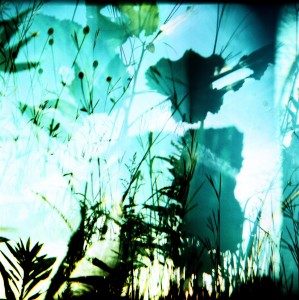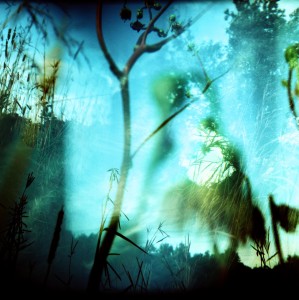September 25, 2009

(c) quintan ana wikswo
Yesterday was one of the special, beloved days – photographic field work. This time, at the old Virginia State Colony for Epileptics and the Feebleminded, where the State of Virginia conducted various tortures during the nazi-linked eugenics movement of the 1930s.
Yesterday, a special day – it was especially intriguing to go on that expedition in Lynchburg with a colleague here – a German artist who creates rather unsettling guache dioramas of bucolic yet sinister woodland settings. His dioramas are peopled with paperdolls: haute coutured women and animals empowered with very heavy weaponry and redirecting their fate against Nazis, the Stasi, Milosovich, and other uniformed representatives of abusive power.
We have similar preoccupations. My cameras are all manufactured by fascist dictatorships in Germany, Eastern Europe, Spain, and Argentina, and were intended for use as war cameras – thus their highly unique physical and technical characteristics. They are soldier-citizen cameras, meant for the common man to document the creation of a new and better society. They are my companions when I explore conflict areas. They seem to understand the nuance, and see the secrets.
So yesterday, we set off in the tremendous heat to go putter around some abandoned buildings of social and historic impact, with cameras and sketchbooks in hand. His sensibilities and life experience proved illuminating and supportive when – at our very last site – I got apprehended for questioning by the Virginia State Police.
Without doubt, the police officer was performing his duties with the utmost responsibility – apprehension of potential yankees with peculiar cameras.

(c) quintan ana wikswo
Throughout the afternoon, we had poked around and photographed condemned and abandoned buildings in the industrial neighborhoods – carefully observing posted signs, and entering only where it seemed clear we were allowed to enter. Due to ethical as well as artistic reasons, I don’t take photographs of people with whom there is no established relationship, and so we waved at folks on their porches as we passed through the residential neighborhoods on route to these various un-peopled sites.
By the time we reached the abandoned Epilepsy hospital where the State of Virginia – with the guidance of Nazi doctors in Germany – conducted eugenics experiments , we were well versed in our laws of conduct: wave at good country people, do not shoot them. Instead, photograph publicly accessible unoccupied buildings. My German colleague had a joyous time with the waving. Until the police officer come to confuse us – how would we reconcile his laws with ours.
There was absolutely no reason given for why I was supposed to be questioned. I asked if I was breaking any laws, and he said, well, you just have to come with me.
I was taken in at sunset, and with the inflexible (nay, relentless) six o’clock VCCA dinner hour fast approached, I struggled with my irrational desire to tell this police officer that I did not have time to assuage his enigmatic concerns because I absolutely could not miss the evening feeding. I felt like a werewolf arguing about the lunar calendar.
While I was most concerned about a secure food supply, my German colleague was astonished that the officer carried a loaded weapon. These people in uniforms with guns are merely humans. It seemed to bother him that such an implement could be placed in easy reach of a highly fallible mortal. My colleague was raised in communist East Germany by the children of Nazi fathers, and he was brought up with a deeply ingrained experience of the Stasi – the East German secret police.
This vision of close-cropped head above brown uniform and gun placed my colleague in a state of GDR reverie, and he began relating lurid anecdotes about deadly May Day beatings in Berlin as soon as I returned to the car for my identification. He murmurs to me, I think these men in uniforms sometimes like their duty a little too much. Sometimes for these people it is simply fun to hit and shoot at people. Sometimes it is hard to tell which ones.
Which people have fun hitting and shooting people? Or which ones to hit and shoot?
He remembered serving in the military with former Stasi officers, who would brag openly about shooting live bullets at suspected dissidents. His dioramas sprang to life in my head – a world in which women and animals are not hunted…because they control all the weapons. Are you listening, Janet Napolitano?
As I stood outside the passenger seat of the rental car, rifling through the glovebox, moment by moment delaying the search for my requested drivers license, I grappled with my predictive issues about what the cop wanted.
I told my colleague that his particular memories were certainly appropriate to the situation, but far from comforting, so he tried another tactic:
Mostly, the more stoned you are, the less bothersome anyone in uniform seems.
This presents an intriguing and perhaps widely-supported causal relationship between drug use and police harassment. Rather than simply being harassed by police because of drug use, why not use additional drugs in order to better endure the harassment of police bothering you about your drug use?
I pointed out to him that I don’t smoke pot, that there were other inherent problems with that tactic, and that regardless I was not stoned now so the advice wasn’t as agreeable as he might imagine. He paused to reconsider.
Well, perhaps he is not actually a policeman. Perhaps he only wants you to think he is a policeman.
That was sound counsel if I ever heard it. I filed it away for immediate use.
It is also possible that whether or not he is or is not a policeman, he likes the law not quite as much as he is interested in ladies.
My colleague shot me a look that was both troubled and calm. I wonder about the refusal to be frightened, or the refusal to appear frightened, to give that reward, to maintain dignity, to refuse to relinquish autonomy in that way. I thought of his high booted women and bears with guns in the woods, frightening the Nazis up into the trees.
Yes, that is quite possible, I said. As I located my ID, I asked my German friend, who knew of Nazis and Stasis, if there was anything more I could quickly learn from the past before entering the present and the future:
He hesitated a moment, then presented new advice: If there are enough of you, there is little they can do in the short term.
I asked about how many of me there needed to be. He swiveled his head and surveyed the scene, shrugged a bit, grimaced, and said he conservatively estimated that there needed to be approximately three thousand of me.
And thus, the idea was for me to go off with this cop – apparently into the eugenics hospital – for questioning, leaving my Nazi progeny, Stasi surviving, politically leftist, feminist social justice artist friend riding shotgun in a car without a pilot deep in the Virginia woods. Ah, life.

(c) quintan ana wikswo
Along with the goons of Russia, this police officer is one more wheel in the cog of complex machinery that is my un-conundrum about how best to navigate my way through photographing anything in a “post 9/11 world,” much less going to sites of conflict and pain and dealing with the response towards witnesses and inquisitors.
Photography can almost always be seen as an act of social power. That makes it rife for anxiety depending on who has and has not the power. May a profusion of blessings fall upon feminist critical theorists for their Medusean work upon the concept of The Gaze, and the ethical considerations for using a camera to dehumanize a life into an object. The gaze – what it means to look, who has the right to look at who, and how, and when and to what effect. When people turn other people into objects. Remove their humanity.
But what can the camera do when it stumbles upon the objects that once were human – can the camera turn these objects back into humans? When does a photograph turn a life into an object? And when can a photograph bring an object back into life?
Perhaps that is what I am trying to do. To rehumanize that which has been dehumanized…making golems, perhaps. Forbidden.
The police officer arrived at the scene of the ruin of the old eugenics hospital, deep in the woods, where throughout much of the 20th century, the State of Virginia sterilized – and committed other crimes against – people with epilepsy, and other neurological illnesses.
What does it mean when wealthy white westerners go photograph sad starving people with flies in their eyes? Is it any different if a sad starving person with flies in her eyes photographs another sad starving person with flies in her eyes? What if it’s a self-portrait? The philosopher Laura Mulvey discusses the phenomenon where a person becomes reduced to being the bearer of meaning, not maker of meaning.
What happens when a person with epilepsy goes to a place where people with epilepsy were tortured by the state? What happens when that torture is done by the state? And that same state still owns that place?
What happens when the State appears in a brown uniform with a gun and a stick and tells the epileptic, I can’t tell you why, but I am using my own laws – that I will not tell you about – to command you to come into this torture site with me for questioning.
After all, the human rights abuses that took place at the Virginia Colony were conducted according to the laws of the State of Virginia – ah, those who think our laws will save us. Conducted by employees of the State of Virginia, just like my man the coon dog. In fact, not only did these Virginia State doctors gain post graduate medical degrees in Racial Cleansing from Nazi-controlled universities – the German Nazi government actually adapted that Virginia State law about eugenic experiments on epileptics and people with conditions affecting the brain. And – using the laws of the glorious State of Virginia – murdered over half a million mentally ill people in Europe within two years.

(c) quintan ana wikswo
As my colleague P. pointed out, a cop (or a soldier) is an object, a cop is a human being, a cop is a representative of something else, and a cop is a social construct…all at the same time. Was this little man commanding me to come into the hospital? Or was the State of Virginia commanding me? Where are the diffferences?
This is partly why cops and soldiers and lawyers and other personifications of power are so difficult. As soon as you try to simplify the human-object entity into one or the other, all the other aspects come out and mess it up. Defy categorization. Evil soldier, killing people was a hippy construct, just like poor helpless boychild, victim of draft is another. Neither work. When humans decide to represent something that is not human – a government, a state, a party – are they a little less than human, or a little more than human? This human, with his gun, given to him by the State of Virginia, to use as he sees fit in accordance to his interpretation of fallible human laws, haphazardly applied.
With his gun, he has the power of mortality. He can kill. Not in his name, as a human, but officially, as the nonhuman representative of an idea. Technically, here in the woods, I could be killed by an idea.
And this man, this walking State, stares at my cameras, and asks me why I standing in the middle of the woods at an old torture site and yet am photographing the sky.
I thought, ah, the State owns this soil, but not the sky. Then I thought about Virginia airspace, and realized well, the State owns the sky, too.
Even before I started taking photographs, I wrote fiction. And before I wrote fiction, I wrote nonfiction in the field of human rights, and did so professionally for twenty years, starting at age sixteen. This meant telling the stories of people who were either victims (dead) or survivors (alive) of human rights abuses (including domestic violence, hate crimes, and civil rights issues).
To publicize the stories of people who had experienced these crimes is difficult ethical terrain – the crimes happen because secrets are kept, but with such shame surrounding them that oftentimes even the victims (or, sadly, the victims’ families) want the secrecy maintained.
In instances where the victims/survivors want their stories told, inevitably there are loud people who think it is wrong to talk about these subjects.
Then of course there are the people who committed these crimes – and their families – who also have their sensitivities.
Between all these parties, simply talking specifics about human rights abuses is difficult ethical terrain, and involved daily conundrum. Often, I was close to the issue at hand because of personal experience of my own or through loved ones. I had my own perspectives and beliefs to question and consider and demolish or uphold.
Traveling for work and working in various locations on various jobs and growing up in the South, I have spent my entire life actually experiencing the places where human rights crimes unfolded. So I became interested in these places visually, instead of just narratively. I knew the stories of the people. With camera, to engage with the places.
Buildings, I reasoned, were objects, and could not be further objectified. Furthermore, public buildings are owned by the public, and I am a member of the public, and so it is as much my building as anybody else’s building. As much my history. In the case of most human rights abuses, the locations of abuse are paid for with public money, for crimes committed in the public name – my name. Again, morally sound right to manipulate its image.
In fact, even the buildings and places must be rendered largely unrecognizable. To pick apart and deconstruct a place and dismantle it photographically until nothing remains. If the place itself cannot be destroyed (or should not be destroyed) what about the process of dismantling it visually? Chemically? with light?
Acting on a place, instead of being victimized by a place.
So yesterday, after a day spent managing my own epilepsy, I asked my colleague to go with me to the site of the old Lynchburg Asylum for Epileptics and Feebleminded, to go photographically dismantle the place right down the street where a few decades ago thousands of people just like me had been sterilized, or lobotomized, or worse.
This place has attained such notoriety in my mind, and the crimes committed here are so atrocious, that it never crossed my mind that the buildings would still stand. Virginia has its fanatical obsession with memorializing its dead, and yet only certain of its dead. Surely this place has fallen into ashes.
And yet we arrive there, at sunset, and the original hospital buildings are there, glowing in the sun.
They look awful. Just awful. These old Southern Georgian-style buildings, once majestic, but now largely ruined – scabrous white peeling paint, cracked and broken windows taped up over and over. Rusted venetian blinds flapping. The red bricks are crumbling around their mortar. Unoccupied, but standing.
The building was too disturbing to photograph, so instead I thought you know, I will photograph the sky. The clouds were gorgeous. I aimed my cameras upwards and photographed the sky.

(c) quintan ana wikswo
What if these buildings never happened? What if the crimes that took place inside the buildings never happened?
It would just be sky, and trees, and clouds at the top of a mountain in the Blue Ridge. I decided to photograph what might have been. What is. What exists independently of the failings of humanity.
I shoot a roll of film in my Nazi camera – it’s pointed up into the sky. Snap. Snap. Snap. Wind. Snap.
My German colleague is inside the car, reeling from the discovery that in the 1930s American citizens earned graduate medical degrees in racial cleansing from German universities and then returned to Lynchburg, Virginia to build hospitals to systematically destroy the undesirables.
We witness these buildings, and stare at the sky.
So I am hauled off by this cop, and I realize that he’s a morass – he’s a mystery. I can fabricate or postulate a panoply of constructions and theories about why he may be hauling me off, but I don’t know for sure.
He asks me, what are you doing?
I say, I am photographing the sky.
Clearly, I am photographing the sky. He has been watching me do exactly that and nothing else for at least ten minutes – my cameras pointed directly overhead. I have in fact pointedly ignored the buildings that surround me, because I am trying to will them out of existence in time and space.
He is furious. Why are you photographing the sky.
I said, calmly, respectfully, Well, the sky here is quite beautiful.
He looks at me, working hard to read my mind.
He says, Legally you are allowed to take photographs here, because they are state buildings.
I said, Yes, I know. Thank you for informing me.
But we are both aware that I’m not actually photographing the buildings. I’m photographing the sky around the buildings.
And that’s where the problem lies. He is there to enforce the law, and I am in some sort of murky queer space in a sort of cumulous heap around the law. He can poke the law at me, but the sharp pointy stick just gets sticky, and stuck.
He says, However, you are going to have to come with me and answer some questions.
I say, No.
He says, Well, you can drive off, but I have your license plate number and the Virginia State Police will not have any trouble finding you.
This is true. My German colleague is listening to the car radio. I tell him goodbye, and we make a few arrangements for various contingencies.
The police officer refuses to speak to me as he leads me off into one of the buildings in the Epilepsy hospital.
I tell myself this would be a very bad time to have a seizure.

(c) quintan ana wikswo
I go through a metal detector into the original intake room – this is where patients must have entered in the 1930s. There are WPA-looking murals on the wall of doctors and nurses in white. They are at least fifteen, twenty feet tall, looming down. There is a retinal-scan camera.
The guard is watching Top Gun on cable TV.
We are going to have to run your information, says the State.
He tells the guard to call the supervisor. We all wait. We all watch Maverick and the airplane mechanics prepare the fighter jets on the aircraft carrier. It’s war.
The supervisor emerges – she is dressed in civilian clothes, and she acknowledges the police officer like he’s a family coon hound on the steps of the outhouse.
His spine goes slack and bowed, and he retreated into a pool of brown gloom in the corner.
The expression he directs towards me changes dramatically, from one of power, privilege and authority to something else. As though I used to be a threat to public safety, to homeland security, whereas now that he is a dog, I am just a nice dumb fat rabbit behind a little thread of chicken wire.
Do you know what this place is? She asks me, sweetly.
Not really, I say. I know there is a lot of history here. But I thought it was abandoned.
She says it’s not abandoned, that it’s very much in use, and absolutely open to members of the public such as myself. Nonetheless, the Police have their job to do. How did you find out about us?
I tell her the truth: I have been doing a lot of work down at the Cemetery.
Oh, she says. Well, we’ve only marked the graves of the Confederate soldiers.
I’m confused. What? I’m sorry, I don’t understand.
Our cemetery, she said, turning her head sideways, equally confused. You said you’ve been taking pictures at our cemetery. I’m telling you – we have Confederate dead. Their graves are marked. But we don’t give gravestones to the patients here.
I was talking about the Lynchburg Old City Cemetery, which is where I heard about the Nazi eugenics movement through my research on the midwives and inter-racial couples that were buried there.
But as it turns out, she accidentally told me about the Epilepsy cemetery here – basically an unmarked mass grave and burial pit in a nearby field, where they have been dumping the anonymous bodies of dead epileptics for nearly one hundred years. Would that I could make golems. Would that I could raise an army from the dead.
The cop looks at me – coon hound to raccoon.
Oh, I said.
We cannot allow you to take photographs of people here, she says.
The supervisor is clearly a born and bred Southerner, because she counts the dead as people.
Even the unmarked dead.
It’s encouraging, in a way, that the dead epileptics are suddenly people, who should not be objectified by my camera.
I told her that I am an artist on a National Endowment for the Arts grant at the Virginia Center for the Creative Arts and that I do abstract photography of architecture and nature, and that I do not photograph people, and I had no idea there was a cemetery on the facility grounds.
But, I didn’t realize there are any living people here, any patients, I said.
At which point she laughed at me. I hadn’t seen any sign of life. Even by Los Angeles’s pathetic standards of human decency, these buildings seemed barely habitable. And there were no visible people. And besides, the buildings still bear the names of the Nazi doctors who sterilized people here. How could those names still be on the buildings? PRIDDY MEMORIAL HALL?
I just couldn’t fathom that the admittedly-criminal eugenics hospitals that I perceived as ruins are, in fact, still used as inpatient treatment centers.
But they are.
She told me that there are thousands of people living there – or receiving treatment there – with severe brain illnesses, physical deformities, debilitating neurological abnormalities, hydroencephilitis, epilepsy, psychiatric illnesses, and various conditions.
I thought of my German colleagues words: If there are enough of you, there is little they can do in the short term. He said there needed to be three thousand of me.
There ARE three thousand of me. But little they can do in the short term…that’s the problem. They’ve had one hundred years. This institute was actually burying epileptics in unmarked, anonymous mass graves for nearly one hundred years.
And besides, we are not a very mobile resistance force – I am one of the few who is walking, and talking, and unmedicated. I am not locked up, locked down, I am mobile, I am free, I am independent. I am not on drugs. I am not in a hospital – well, I was in a hospital at the moment, but not as a patient.
The supervisors tells me the patients are not allowed to be photographed.
I understand completely, I said. Patient privacy is to be respected. Absolutely. I didn’t know these buildings were still being used.
She laughed again. Well, I’m not sure it’s patient privacy, she said.
She told me that even the patients are not allowed to photograph each other. She said that oftentimes patients cry because they cannot photograph their best friends, but that the policy is driven by the patients’ families.
You see, the families are oftentimes very ashamed that they have a family member here, and although they could release permission for their children or relatives to take pictures, they do not release permissions because “many of the conditions are very embarrassing to families” and they would not want a photograph of a disfigured family member to be seen by the public.
Oh. I understand completely.
So while these people are not objectified by a camera, they are also invisible. They do not exist. They are cleverly removed from the gaze, but also from view, from self-portrait, from taking control over their own images.
How do you worry about objectifying someone that doesn’t even exist?
There are no pictures of them. There are no grave markers.
I have come to pay my respects, and I am shown an open field and given a blindfold.
However, she said, you can definitely apply for permission for architectural photography, and be assigned an escort who would ensure that no people appeared in you photographs.We would be most happy to give you that permit.
But someone else tells me, you should prepare yourself for what you might see if you chose to walk around the grounds.
They are talking about the patients.
…
….
…
speechless.
…
…
…
At this point, the clock struck six, and the coon hound began to rouse himself from his dull glower at the back of the intake center. Ma’am, he said to the supervisor, as though wondering about his evening meal.
Six is the hour of the VCCA meal, and my German friend was mouldering in the car, and we were still a twenty minute drive from Amherst. The coon hound somehow managed to herd me and the supervisor onto the front steps of the building.
She handed me her card, and began some small talk. I excused myself, and began walking towards the car in the dark.
As I walked away, I heard a banging sound – fists pounding on glass.
I turned around, and it was the supervisor, knocking with all her might against the glass and steel security doors into the florescent-lit hospital intake foyer.
The police officer had locked the doors behind us, locked her out.
From where I stood in the dark, I could see his brown silhouette, his nightstick and holster illuminated within the brightly lit building, a figure standing at the feet of those twenty-foot tall white painted doctors and nurses,who gazed implacably down on us all from the wall.

(c) quintan ana wikswo
PLEASE READ:
http://www.usatoday.com/news/health/2009-06-23-eugenics-carrie-buck_N.htm
http://www.eugenicsarchive.org/html/eugenics/essay8text.html

Lovely. Riveting. Wonderful.
psh
Indeed, totally chilling!
Scintillating account about fascinating aspects of Americana. Never have liked cops who in the form of INS officers (la migra) harassed me while young and Mexican in Calexico, Ca., shot me in East LA while a college student and still Mexican, and broke my front teeth inside the LA Sprots Arena while watching Olympic boxing between the USA and Cuban teams. Excessive force thrives. Seems they are in all corners of the USA. Brutes with inferiority complexes. I’m lucky I haven’t been waterboarded. Agree that your account was riveting… and frightful.
Unbelievable.
And yet, so infuriatingly believable. Dammit, it hurts to see. But it’s better to see. Thank you for helping us see.